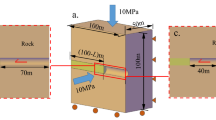Abstract
Inspired by studies of tunnel monitoring by the three-dimensional laser scanning, this paper aims to explore the synchronization of primary support deformation and surrounding rock deformation and the feasibility of non-contact measurement method for primary support of tunnel. The deformations of tunnel under external conditions such as full-face excavation, three-bench excavation, initial defects, shallow buried, and bias were simulated in ANSYS. The maximum entropy theory was used in the simulation results, and the primary support deformation and surrounding rock deformation of the tunnel were analyzed by the probability density function. The results showed that the primary support deformation and surrounding rock deformation was synchronized in most conditions, which proved the feasibility of non-contact measurement method for primary support of tunnel. However, the vault void had a great influence on the deformation curve of upper bench excavation. It was suggested that the field test should be carried out to verify whether the traditional monitoring results are consistent with the three-dimensional laser scanning results in this condition.







Similar content being viewed by others
Availability of Data and Materials
All data generated or analyzed during this study are included in this manuscript.
Code Availability
All codes generated during the current study are not publicly available due to the demand of the funding, but are available from the corresponding author on reasonable request and with permission of the funding.
References
He C, Wang B (2013) Research progress and development trends of highway tunnels in China. J Mod Transport 21(4):209–223
Luo YB, Chen JX, Xi WZ et al (2016) Analysis of tunnel displacement accuracy with total station. Measurement 83:29–37
China Railway Corporation (2015) Technical specification for monitoring measurement of railway tunnel Q/CR 9218–2015. China Railway Press, Beijing, China (in Chinese)
Wang XD (2019) Application of long distance microscope and three-dimensional laser scanner in tunnel section detection. Acta Microscopica 28(5):1099–1107
Fekete S, Diederichs M, Lato M (2010) Geotechnical and operational applications for 3-dimensional laser scanning in drill and blast tunnels. Tunn Undergr Space Technol 25(5):614–628
Han JY, Guo J, Jiang YS (2013) Monitoring tunnel profile by means of multi-epoch dispersed 3-D LiDAR point clouds. Tunn Undergr Space Technol 33:186–192
Wan CH, He XP (2016) Tunnel monitoring method based on 3D laser scanning technology. In: 2016 international conference on computational modeling, simulation and applied mathematics, p 110–114
Wang WX, Zhao WS, Huang LX et al (2014) Applications of terrestrial laser scanning for tunnels: a review. J Traffic Transp Eng (English Edition) 1(5):325–337
Gikas V (2012) Three-dimensional laser scanning for geometry documentation and construction management of highway tunnels during excavation. Sensors 12(8):11249–11270
Fekete S, Diederichs M (2013) Integration of three-dimensional laser scanning with discontinuum modelling for stability analysis of tunnels in blocky rockmasses. Int J Rock Mech Min Sci 57:11–23
Yang SL, Wang B, Ji SY, Liu WN, Shi HY (2005) Non-contact monitoring and analysis system for tunnel surrounding rock deformation of underground engineering. Trans Nonferr Metals Soc China-English Edition 15(1):88
Shannon CE (1948) A mathematical theory of communication. J Franklin Inst 28:379–423
Edward JA, Fitelson MM (1973) Notes on maximum-entropy processing. IEEE Trans Inf Theory 19(2):232–234
Thomas MU (1979) Technical note—a generalized maximum entropy principle. Oper Res 27(6):1188–1196
Zhao YG, Lu ZH (2007) Applicable range of the fourth-moment method for structural reliability. J Asian Arch Build Eng 6(1):151–158
Aygar EB (2020) Evaluation of new Austrian tunnelling method applied to Bolu tunnel’s weak rocks. J Rock Mech Geotech Eng 12(3):541–556
Rehman H, Naji AM, Ali W et al (2020) Numerical evaluation of new Austrian tunneling method excavation sequences: a case study. Int J Min Sci Technol 30(3):381–386
Ng CWW, Lee KM, Tang DKW (2004) Three-dimensional numerical investigations of new Austrian tunnelling method (NATM) twin tunnel interactions. Can Geotech J 41(3):523–539
Ministry of Railways of the People’s Republic of China (2005) Code for design on tunnel of railway TB 10003—2005. China Railway Press, Beijing
Niu HT (2012) Simulation method of tunnel excavation under plane strain condition. Appl Mech Mater 170–173:1753–1756
Li XH (2008) Determination of load releasing rate during numerical simulation of tunnel excavation. Soil Eng Found 22(3):66–69
Acknowledgements
The authors would like to extend their sincere gratitude for the financial support from the department of transportation of Zhejiang Province of China (2019015).
Funding
The financial support from the department of transportation of Zhejiang Province of China (2019015).
Author information
Authors and Affiliations
Contributions
Formal analysis and investigation, writing—original draft preparation, and writing—reviewing and editing: ZW. Conceptualization, methodology, and writing—reviewing and editing: ZD. Conceptualization and methodology: ZZ. Formal analysis and investigation: YH.
Corresponding author
Ethics declarations
Conflict of Interest
No conflict of interest exists in the submission of this manuscript.
Ethics Approval
Not applicable for that section.
Consent to Participate
Not applicable for that section.
Consent for Publication
Not applicable for that section.
Additional information
Publisher's Note
Springer Nature remains neutral with regard to jurisdictional claims in published maps and institutional affiliations.
Rights and permissions
About this article
Cite this article
Wei, Z., Ding, Z., Zhou, Z. et al. Feasibility Study on Non-contact Measurement Method for Primary Support of Tunnel. Int. J. of Geosynth. and Ground Eng. 7, 52 (2021). https://doi.org/10.1007/s40891-021-00303-9
Received:
Accepted:
Published:
DOI: https://doi.org/10.1007/s40891-021-00303-9




